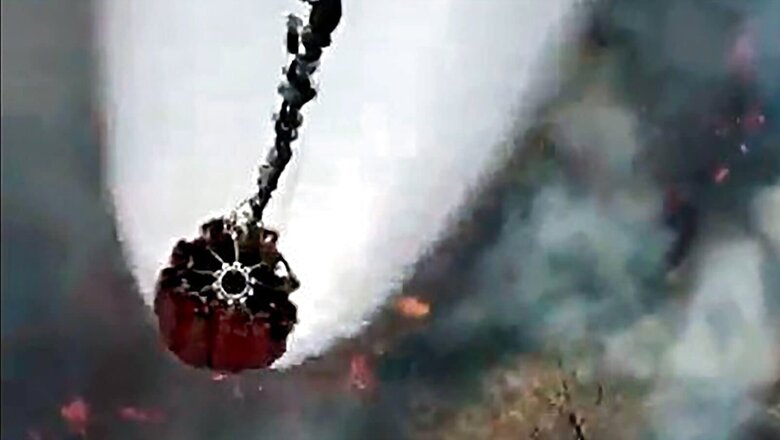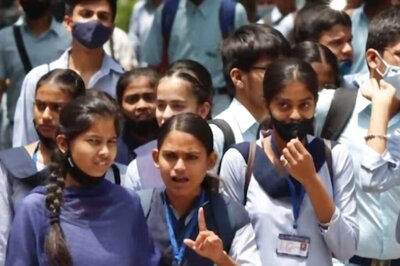
views
A fire raged within Rajasthan’s Sariska Tiger Reserve for the fourth day late Wednesday but the flames were now confined to a just one pocket, after a firefighting operation involving 400 people and two IAF helicopters, officials said. The fire was brought under control by nearly 80 percent till the evening. The flames are left on just one hillock now, Rajasthan’s Principal Secretary-Forest Sreya Guha told PTI.
At one time the wildfire had spread over an area 10 sq km in the forest reserve in Alwar district. Guha said once the fire is under full control, an assessment of the total area scorched by the blaze will begin. Our top priority is to control the fire,” she said.
Earlier in the day, a forest official said the situation, developing since Sunday, was now almost under control in areas with thick easy-burning dry grass. But in the morning, flames still raged across a swathe of four or five square kilometres. By evening, the fire had died down over an even bigger area. About 400 people, including forest staff, nature guides, the State Disaster Response Force (SDRF) people, remained engaged in the firefighting operation.
Tiger-crawling Rescue Ops
Four adult tigers and five cubs move around the area where the fire broke out. But officials claimed no tiger was stuck in the area. The reserve in Alwar district has 27 tigers. The blaze had started on Sunday evening and was brought under control on Monday. But it flared again the same evening and continued through Tuesday, spreading up to an area of over 10 sq km at one point in the day.
Two IAF helicopters were deployed in the firefighting on Tuesday and flew 22 sorties over two days, spraying water on the affected area. The firefighting operation was halted on Tuesday night and resumed Wednesday morning. But the blaze did not spread to a larger area overnight, officials indicated.
Two SDRF teams comprising a total of 25 personnel have been deployed. They assisted the forest staff in the manual dousing of the fire and stopping the spread of the flames by digging trenches, commandant Pankaj Chaudhary said.
Heat wave & Climate Change
Since mid-March, large parts of Rajasthan, including Alwar district – home to Sariska Tiger Reserve – have been witnessing heat wave conditions.
“The forest fires in the Sariska Tiger Reserve look like a case of extreme heat exacerbating the fire. The intensity and increasing frequency of forest fire also points to the dangers this poses for biodiversity and the decades of efforts which have gone into wildlife conservation. These temperatures are much ahead of any predicted seasonal heat waves and speaks to non-linear impacts of climate change in some ways,” Aarti Khosla, Director, Climate Trends, an advocacy non-profit told IANS.
This was echoed Ravi Chellam, a member of Biodiversity Collaborative, a network of institutions and individuals promoting biodiversity research and conservation.
“Forest fires are part of the natural ecology of many ecosystems across the world. In fact, there are many habitats and species which are fire dependent. (But) It is the increasing frequency, intensity and scale of these fires which is aided and exacerbated by climate change and that too in the context of accelerating loss, fragmentation and degradation of habitats which is the problem.”
Former Member Secretary, National Tiger Conservation Authority (NTCA), Rajesh Gopal, however, differed.
“India does not have forest fires due to increased natural heat wave conditions unlike the bush fires in other countries. We mostly have man-made fires. The only thing is, heat waves means biomass is dry and that helps spread the fire faster,” Gopal said.
Forest fire is not a new thing either for Sariska or Rajasthan but the extent to which fire spread this time is larger, he said, adding, the bigger animals are hardly affected but damages ground nesting and smaller animals. “If there are shortfalls in prevention measures, the fire can turn into crown fire, in which case, a large number of trees are lost,” he said.
A WWF International report from 2020 estimated that humans are responsible for around 75 per cent of all wildfires and much of the increase in fire incidents during 2020 can be directly linked to human actions.
Forest Fires Across India
Sariska is neither the only place nor Rajasthan the only state that saw forest fire. According to the Forest Survey of India (FSI) report, the forest fire season in the country is normally from November to June and with majority fires being caused due to man-made reasons.
More than 36 per cent of India’s forest cover has been estimated to be prone to frequent fires. Nearly four per cent of the forest cover is extremely prone to fire whereas six per cent is found to be very highly fire prone, the FSI report said.
During the forest fire season 2019-2020, the number of hotspots detected by two satellite sensors was 22,447 and 1,24,473 while in the fire season 2020-21, the total hotspots were 52,785 and 3,45,989 respectively.
In 2020-21, among the states, the maximum number of fire detections were observed in Odisha (51,968) followed by Madhya Pradesh (47,795), and Chhattisgarh (38,106); Rajasthan does not even figure in the top 10.
The FSI issues pre-fire alerts using overlaying factors such as rainfall, rather the deficit of rain, inputs from the Meteorological Department, satellite data from NASA and the forest cover layer etc. “Apart from these pre-fire alerts, we also issue a Fire Danger Rating System. After the pilot that started in 2016, we started for all India from 2019-20,” said Sunil Chandra from the FSI.
Using two satellites’ inputs, the FSI generates real time alerts about forest fires every six hours and those are sent to state Forest Departments. “Also, there are 1.36 lakh registered users of our service, including NGOs, Panchayats, state departments and even individuals,” Chandra said.
PM Speaks to CM Gehlot
Meanwhile, Prime Minister Narendra Modi on Wednesday spoke to Rajasthan Chief Minister Ashok Gehlot and expressed concern over the fire in Sariska Tiger Reserve and offered all possible help, according to reports.
With inputs from PTI, IANS
Read all the Latest News India and Breaking News here




















Comments
0 comment